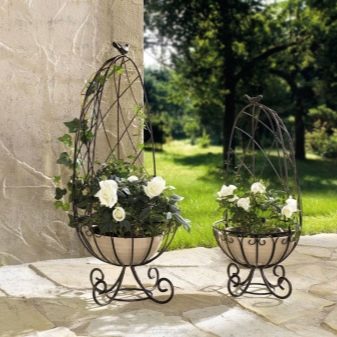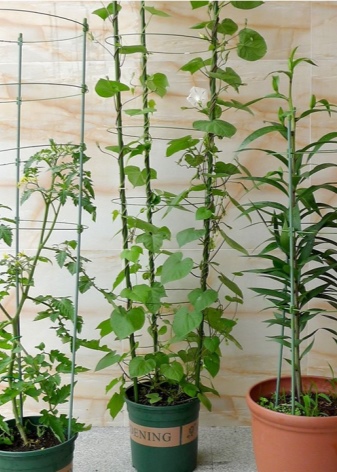Holders for flowers in pots: features, types and selection criteria

Holders for garden and indoor plants, in addition to decorative functions, help plants whose stems are not strong enough, giving them the desired shape, affect growth. To achieve the desired effect, you must choose the right support. What types of holders exist, as well as their features, we will consider in more detail in this article.
Features of use
Holders are made from various materials: natural and artificial. When choosing a support, they are guided by the type of flower and the installation location. Clips made of natural thin materials: bamboo, willow rods installed outdoors are more susceptible to deformation due to weather conditions. In wet weather, mold and fungus develop on the supports, and the material exfoliates. These consequences can have a negative impact on plants.


For outdoor areas, it is better to use metal and plastic products. The service life of such holders is from 7 years. Monolithic wooden products are subject to decay over time, after 10-15 years it is necessary to replace the support. Structures are different in shape, weight, moisture resistance.


Plastic supports can burst at low temperatures, so it is recommended to remove them for the winter.


Holder types
Metallic
A metal mesh or welded structures of various shapes are used as a support for plants. The grids are placed on fences, poles, house facades. They go on sale to specialized stores in the form of rolls. The material is fixed to the surface with self-tapping screws. As the plant grows, the mesh ceases to be visible, so the material is used for pack plants. The netting is also used as an anchor for hanging pots, creating the effect of hanging gardens.
For low plants, wire and fittings are used. The material is made in the form of rings held together by vertical stripes. The posts are placed superficially on the ground or buried in the ground. Before using the support, it must be sanded, primed and painted, predominantly green. The long metal supports are used indoors as a multi-level stand for potted crops. They represent a pipe from 2 meters or more with branched rings at different levels. Fixed on the floor or ceiling using a special stand or self-tapping screws.






Wooden
Wooden poles are an environmentally friendly and durable material. They are presented in the form of a large mesh, which is used as a fixer for pack plants, roses and as a decorative divider. Monolithic structures are used in the form of a vertical support for flowers in pots. When placing the holders on the street to increase the service life, wooden surfaces are treated with varnish or moisture-proof and antifungal impregnations.
In living quarters, wooden holders are ladders, decorative stands, shelving. All of them are subdivided into mobile and stationary holders. Each species has its own advantages and disadvantages. Mobile supports are suitable for heavy planted crops, thanks to the installed castors, the holder with the pot can be easily moved in space.Due to the possibility of placing only one flower, mobile supports outperform stationary ones in the amount of light received by the plant.
With the mass placement of crops designed for large weight, stationary supports are chosen. Placed on any surface, up to window frames, which allows efficient use of space. The design of multi-tiered shelving allows you to install night lights for indoor plants, store items for plant care.



Bamboo
Bamboo sticks are used to fix vines, as a support for orchids. When forming structures, the joints of the bamboo sticks are fixed with a rope. The thick trunks of bamboo are used on their own. The material is buried a quarter into the ground, fixed with special clamps. Such stable structures are support for large crops: palms, various loaches, citrus fruits and other trees.
Since bamboo is a fairly plastic material, surface treatment with plastic and varnish is recommended to increase the strength of the product. When installing a suspended bamboo frame at home, the diameter of the holes in the ceiling should correspond to the diameter of the trunk, the depth of the recesses should be up to 2 cm.


Floor holders for pots are presented in a wide range of models: baskets, stands, trellises.


Plastic
Lightweight and practical material with direct and decorative functions. Plastic structures are fixed on the walls in the premises, deepened into the ground, concrete is used to give strength to the base. Nets, vertical supports, arches and other structures are made of plastic elements. They are mainly used for light plants.


Decorative
Decorative supports are made in the form of brackets with various patterns. Made of plastic, metal and wood. They are divided into wall, ceiling, balcony. The wall holder for potted flowers can fix the plant in a horizontal position with a stand or ring, in an upright position for hanging planters. Made from natural materials. Presented in the form of ropes, suspended multi-level structures.


Balcony supports are presented in the form of hooks or hangers, most often made of metal, fixed with screws or by overlaying on the support of the balcony railing. Iron supports are used to place flower baskets, boxes, tubs. Plastic holders are not recommended as they do not have sufficient capacity to support heavy baskets of plants, especially when soil is moistened. Suitable for placing artificial flowers and plastic boxes.

Ceiling ones are made in the form of an ordinary hook, which is fixed to the ceiling with self-tapping screws and a holder attached to it or supplied in the kit in various forms: rope, soft material with pockets, lamps, and others. Serve for placing hanging pots, flower installations. Chairs, suitcases, vases and other items are used as creative decorative holders.


Requirements
Every kind of holders must comply with safety and durability requirements.
- The support must support the weight of the installed flower pot, secure it and be stable.
- Holders should not be placed on loose surfaces, not fixed to materials prone to crumbling.
- Practicality. The support must be suitable for the particular plant.
- Security. Made from sustainable materials. Surface treatment with protective impregnations.
- Attractive look.


How to do it yourself?
Before starting the manufacture of the holder, you need to decide on the location of the flower. When placed on the wall, you can use small boards connected in the shape of the letter T. One side is fixed flat on the wall, the other acts as a stand.Another classic option is a support in the shape of the letter P. You can make from wooden materials or use ready-made metal corners and glass on which the plants will be placed.
For the mounted version, you should take the required number of boards with a width of at least 15 cm. In each board, 4 holes must be made, located along the edges of the material. A rope or thick strong rope is threaded through these holes. In order for the boards to hold each at its own level, it is necessary to tie a knot on each rope under the board. As a floor support, you can use decorative balusters that will serve as legs and any tabletop.
Making iron supports requires special skill, or you can use metal pipes. The pipes are connected to each other using clamps to form a simple geometric shape, such as a rectangle. At the junction, props are installed from various materials in the right amount.
Such a simple design does not look bulky and provides sufficient access to the sun's rays to the plants.

See below for a master class on making a holder.













The comment was sent successfully.